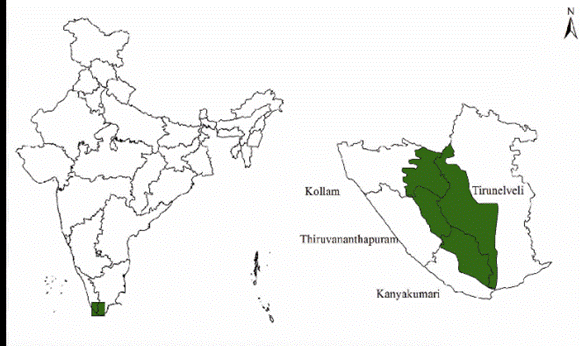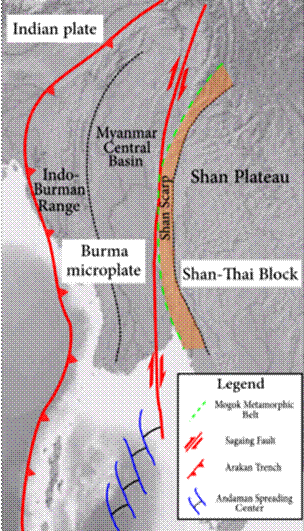
Content:
- China hits back with 34% tariff on all U.S. products
- SC directs CEC to survey forests in Agasthyamalai for encroachments
- CSIR-NAL signs technology transfer deal with firm to make HANSA trainer-planes
- U.S. tariffs may pare India’s FY26 real GDP growth by up to 0.3%’
- Week after massive earthquake, focus shifts to humanitarian crisis in Myanmar
China hits back with 34% tariff on all U.S. products
Context :
- China imposes a 34% tariff on all U.S. imports effective April 10, mirroring the U.S. 34% tariff on Chinese goods.
- This move is a direct retaliation to President Trump’s ‘Liberation Day’ tariff hike, aimed at asserting “reciprocity.”
Relevance : GS 2(International Relations ) , GS 3(International Trade)
Escalation of Trade War
- U.S. tariffs under Trump target Chinese exports, citing unfair trade practices.
- China’s retaliatory tariffs reflect a tit-for-tat escalation, intensifying the U.S.–China trade war.
Rare Earth Export Controls
- China’s Commerce Ministry announced exportrestrictions on rare earth elements, critical for:
- High-tech products (e.g., computer chips, EV batteries)
- Defense & Aerospace (e.g., samarium)
- Healthcare (e.g., gadolinium for MRI machines)
- These controls are likely to disrupt global tech supply chains, especially in the U.S. defense and electronics sectors.
Food Safety Actions
- China suspended chickenimports from certain U.S. suppliers due to:
- Detection of furazolidone, a banned drug.
- Salmonella in poultry.
- High mold content in sorghum shipments from C&D Inc.
- These actions may be seen as non-tariff barriers, adding pressure on U.S. agribusiness.
Trump’s Response
- Trump’s social media post blames China for reacting emotionally:
“They panicked — the one thing they cannot afford to do!”
Geopolitical & Economic Implications
- The confrontation may impact:
- Global trade stability
- Stock markets and investor confidence
- Supply chains involving rare earths and agricultural commodities
- China is leveraging its strategic monopoly on rare earths as a geopolitical weapon.
- The trade war’s impact will be felt beyond U.S. and China, affecting global economic growth and multilateral trading systems.
SC directs CEC to survey forests in Agasthyamalai for encroachments
Context : Supreme Court’s Directive
- SC Bench of Justices Vikram Nath and Sandeep Mehta ordered an extensive forest survey in the Agasthyamalai region.
- The Central Empowered Committee (CEC) is tasked with identifying non-forestry activities and encroachments.
- Described as an interim step to restore pristine forests and protect tiger habitats and wildlife sanctuaries.
Relevance : GS 3(Environment and Ecology)
Ecological Significance
- Agasthyamalai Biosphere Reserve:
- Spans 3,500 km² across Tamil Nadu and Kerala.
- Recognized by UNESCO as a global ecological hotspot.
- Tropical forest landscape includes:
- Periyar Tiger Reserve
- Srivilliputhur Grizzled Squirrel Wildlife Sanctuary
- Meghamalai & Thirunelveli Wildlife Sanctuaries

Survey Objectives
- Provide comparative data: past vs current forest cover.
- Assess extent of forest degradation and depletion.
- Support restoration efforts for critical biodiversity zones.
Broader Concerns Highlighted
- Climate change linkage: Depletion of forest cover fuels global climate issues.
- Primary causes: Rapid urbanisation, industrialisation, and long-term encroachments.
- Historical exploitation: Over a century of plantation activity and encroachments have damaged the landscape.
Legal and Human Context
- Based on submissions by amicus curiae K. Parmeshwar.
- Part of a larger petition on:
- Protection of reserved forests and tiger reserves in Tamil Nadu.
- Rehabilitation of displaced workers from the Bombay Burma Trading Corporation tea estate after the land was declared a protected area.
CSIR-NAL signs technology transfer deal with firm to make HANSA trainer-planes
Context & Background
- CSIR-NAL (National Aerospace Laboratories) is a premier aerospace R&D organization under the Council of Scientific and Industrial Research (CSIR).
- HANSA aircraft series: Originally developed in the 1990s, HANSA is India’s first all-composite light aircraft, mainly used for pilot training and research.
Relevance : GS 3(Science and Technology)
Key Development
- Technology Transfer Agreement (ToT):
- CSIR-NAL has signed a ToT deal with Pioneer Clean AMPS Pvt Ltd, marking the first private manufacturing partnership for trainer aircraft designed indigenously.
- This is the first time a fully indigenous civil aircraft technology will be manufactured at scale by a private firm in India.
About HANSA-3 NG
- Type: Two-seater Next Generation (NG) trainer aircraft.
- Engine: Equipped with a Rotax Digital Control Engine.
- Features:
- Lightweight composite airframe
- Glass cockpit
- Electrically operated flaps
- Bubble canopy for wide panoramic visibility
- Use Case: Ideal for flight training, surveillance, and light utility roles.
Significance
- Make in India & Atmanirbhar Bharat:
- Boosts self–reliance in civil aviation.
- Demonstrates India’s capacity to design and manufacture civil aircraft.
- Aerospace Ecosystem Development:
- Encourages private sector participation in aviation manufacturing.
- Can catalyze growth of Tier-2/Tier-3 aerospace supply chains.
- Training & Skill Development:
- Helps bridge the demand-supply gap for trainer aircraft in India.
- Supports aviation academies and civil flying clubs.
Challenges & Way Ahead
- Scalability: Ensuring production at economic scale with consistent quality.
- Certification & Compliance: Must meet DGCA norms and global aviation standards.
- Market Acceptance: Competing with foreign trainer aircraft in domestic and global markets.
- R&D Continuity: Ongoing tech upgrades needed to stay relevant.
Conclusion
The ToT agreement between CSIR-NAL and Pioneer Clean AMPS is a strategic leap in India’s civil aviation sector. It reflects the synergy between public R&D and private enterprise, laying a foundation for indigenous aircraft manufacturing ecosystem with global aspirations.
‘U.S. tariffs may pare India’s FY26 real GDP growth by up to 0.3%’
The U.S. under President Trump has announced new tariffs on select Indian exports. This move is expected to reduce India’s FY26 GDP growth by up to 0.4%, primarily through export losses and currency depreciation.
Relevance : GS 3(Indian Economy)
Impact on GDP Growth
- Bank of Baroda(BoB) Estimate: Real GDP growth revised down to 6.6% from the Budget’s 6.8%.
- Barclays Estimate: Even more conservative, 6.5% growth projected.
- Monetary effect:
- Budget expectation: ₹200.7 lakh crore GDP.
- BoB revision: ₹200.3 lakh crore (₹40,000 crore loss).
- Barclays revision: ₹200.1 lakh crore (₹60,000 crore loss).
Export Sector Disruption
- Affected exports: 9–11% of India’s exports to the U.S.
- Sectors hit: Electronics, gems & jewellery, machinery, garments.
- These are MSME-heavy sectors, making them highly vulnerable to demand shocks.
- Value at risk:
- FY24 exports to the U.S.:₹6.4 lakh crore.
- 10% impact =₹64,000 crore in potential export losses.
- Already a 2.4% decline in exports till Jan 2025 before tariff effect.
Exchange Rate Volatility & Inflation
- Expected depreciation of INR → raises import costs, especially for crude oil and electronics.
- BoB model:
- 10% depreciation → WPI inflation rises by 0.12–0.16% short term, 0.38–0.49% long term.
- Why WPI? Because it tracks wholesale and tradable goods, unlike CPI which includes more services and rural consumption.
Monetary Policy Outlook
- Rate cut expected: Elara Securities predicts 50 bps rate cut by RBI in FY26 to offset slowdown.
- RBI dilemma:
- Growth needs stimulus via lower rates.
- But depreciation-led inflation may limit space for aggressive cuts.
Corporate Earnings & Bank Exposure
- Tariffs may force exporters to cut prices to stay competitive.
- This can erode profit margins and trigger layoffs or reduced production.
- Banks at risk: Sectors hit are MSME-heavy—a segment with already higher NPA concerns.
Government & Diplomatic Response
- Ministry of Commerce: Negotiations with the U.S. are underway.
- Way Forward :
- Exploring bilateral trade deal provisions.
- Diversifying export destinations to reduce U.S. dependency.
- Targeted sectoral relief for MSMEs.
Week after massive earthquake, focus shifts to humanitarian crisis in Myanmar
Context : Immediate Impact of the Earthquake
- Magnitude: 7.7 on the Richter scale; epicenter near Mandalay.
- Casualties: Over 3,145 people dead, 4,589 injured, and 221 missing.
- Widespread destruction: Infrastructure damage in Mandalay, Naypyitaw; tremors felt in Thailand (Bangkok), causing additional casualties.
Relevance : GS 2(Social Issues) ,GS 3(Disaster Management )
Humanitarian Crisis Intensifies
- Pre-existing crisis: Myanmar already had 20 million people in need of aid and 3 million internally displaced persons (IDPs) due to civil conflict.
- Post-quake escalation: Destruction of homes and facilities has worsened displacement, food insecurity, and shelter shortages.
- Monsoon threat: The oncoming monsoon season could exacerbate the suffering, hinder relief operations, and increase risks of disease outbreaks.
International Humanitarian Response

- UN action: UN Emergency Relief Coordinator Tom Fletcher visiting to mobilize aid; Antonio Guterres has called for unimpeded humanitarian access and urgent funding.
- World Food Programme:
- Has reached 24,000 people.
- Plans to assist 8.5 lakh survivors with food and cash aid for one month.
- Foreign aid:
- UK: $13 million initial aid + $6.5 million additional commitment.
- USA: $2 million pledged despite foreign aid cuts; a three-member team dispatched.
- ASEAN + regional players: Medical and search teams from China, Thailand, India, Japan, Russia, Bangladesh, Bhutan, Laos, Singapore, Indonesia, Nepal, Malaysia, and others.
Civil War Complicates Relief
- Military coup (2021): Junta took power from Aung San Suu Kyi’s government, triggering ongoing civil war.
- Ceasefires declared: Both the military and key armed resistance groups declared temporary ceasefires post-quake.
- Violations reported:
- UN Human Rights Office: Over 60 attacks after the quake, including 16 post-ceasefire declaration.
- Resistance groups and military remain distrustful; ceasefires are conditional.
Challenges to Aid Delivery
- Access restrictions: Military control, continued fighting, and logistics hinder equitable aid distribution.
- Political distrust: Military warned of action if ceasefire is “misused” by resistance groups; rebels reserve right to self-defense.
- Call for neutrality: UN High Commissioner Volker Turk urged halt to military actions and prioritization of aid.
Regional Impact: Thailand
- Bangkok tremors: Collapse of an under-construction high-rise.
- Casualties in Bangkok: 22 dead, 35 injured; most at the construction site.
Key Takeaways
- Compound crisis: Earthquake has deepened a multi-dimensional humanitarian and political crisis.
- International urgency: Aid is trickling in but far below required levels.
- Access and neutrality are critical challenges, as political instability blocks equitable aid flow.
- Turning point? Global actors hope this tragedy can trigger dialogue and de-escalation in Myanmar.
